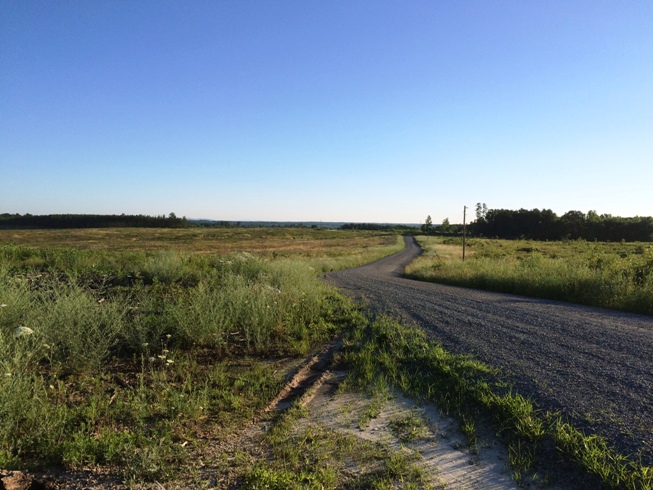My landowner friend of over 20 years and I stood and looked out over almost 900 contiguous acres of clear-cut, or “cut-over” as most folks in Southside Virginia know it. Now please don’t start a

letter writing campaign about the wholesale pillaging of the landscape. Most of these acres came from old farm land replanted to loblolly pines years ago. And they have now become a retirement fund. Keep in mind if the land does not pay in crop or timber, it’s likely to pay in house lots sold piece-by-piece. Forestry Best Management Practices were followed in the harvest and what exists now is 900 acres of brand new, one, two or three years post planting pines. In addition to that, my friend is an “old time bird hunter.” He plants most of his log decks, road edges, and power line rights-of-way with legumes.
As we stood looking over the land, I mentioned I was sure quail would return here quickly. My friend was less sure. He asked me “Marc, where are the birds going to come from? There’s none nearby to repopulate the area. We need to bring some quail in.” I made a bet with him … if quail did not show up this spring I’d bring in some quail.
This morning I got up at 4:30, got in my work truck and made it to the gravel road that bisected this cut-over area by 6:50. It was an absolutely magnificent morning with cool, clean skies the likes of which we see few of during summer. I did five “official” points between then and 8:00 a.m. and…I heard 13 different bobwhites calling, an average of 2.6 per point. The points did not cover the entire area. So there may have been many I did not hear. I would say this habitat had been “found.”
Quail move more than many people think. I have mentioned in posts before they are ”hardwired” to move and that it is a genetic mechanism that has helped them survive at low densities for many decades. And it also allows their populations to “explode” when conditions are ideal.
If you picture a covey of 12 quail on April 1, they soon “disintegrate” with some moving very little, some moving a bit and some moving several miles. Thinking of their “radius of influence,” though, it might span several miles in any direction from their winter range. And this increases the chances that they can “find” new habitats and mates.
But, most folks don’t have 900 acres of contiguous habitat. And 50 acres of cut-over within the context of 1,000 acres of more cut-over has a much greater chance of being occupied through time than 50 acres of cut-over isolated from other such areas. So what’s a landowner to do who only owns 100 or 500 acres?
Talk to your neighbors. Develop quail cooperatives. Help each other. Quail cover can be produced on cut-overs, in fallowed crop fields and power line rights-of-way, around field edges, and in a variety of other ways. And the bottom-feather is, the more acres the merrier.
By the way, why translocate wild quail to anyone’s property if quail show up on their own? Very good question and one that is still undergoing research, but the short answer is – it might speed up recovery, inject some new genetics into a population, and keep landowners interested in continued habitat management. It may also help existing quail populations to overcome an unknown threshold preventing their recovery.
Much “to do” has been made about translocation efforts in other states. Criteria being used now for those translocations require a minimum of 1,500 acres of contiguous high quality quail habitat before quail will be translocated to those properties, and all the translocations are experimental. In some cases “success” has been declared. To me that is akin to if the Allies had declared success a week after D-Day. In my opinion these projects are showing short-term success and I am optimistic, but long-term success has yet to be demonstrated. We are developing similar criteria for research in Virginia, so start thinking ahead about how to put together habitat cooperatives, something we have referred to in the past as “Quail Quilts.”
Another intriguing aspect of quail ecology is “where do they disappear to in winter?” Many landowners and quail hunters enjoy hearing a good number of quail in summer, only to have a hard time finding these “ghost” quail in winter. Though we do have some older data on winter habitat use by quail in Virginia, we don’t have much from modern times.
We have long theorized that the “modern quail” has adapted to survive and those remaining have become harder and harder for hunters and predators to locate. We have observed from some late winter trapping for summer quail studies, that in late winter during the day quail inhabit the thickest tangles of cut-over or creek bottom canebrake they can find. And they leave it only long enough to feed and quickly return. I caught very few quail in places where I was not getting scratched severely by briers and brush when putting the trap in.
We have a couple places in mind for a study where we hear good numbers of quail during summer and early fall counts, but where hunters struggle to find a covey or two in winter. We’ll be submitting a request for proposals for a research project to help us find some answers specific to Virginia. In the meantime, go enjoy June – get up early and go listen for some bobwhites.




